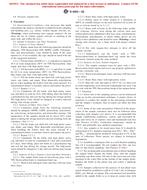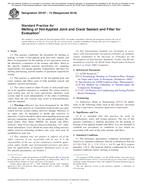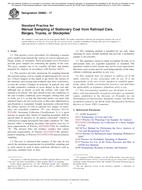1.1 This test method covers procedures and guidelines for the determination of fracture toughness of metallic materials using the following parameters: K, J, and CTOD (δ). Toughness can be measured in the R-curve format or as a point value. The fracture toughness determined in accordance with this test method is for the opening mode (Mode I) of loading.
1.2 The recommended specimens are single-edge bend, [SE(B)], compact, [C(T)], and disk-shaped compact, [DC(T)]. All specimens contain notches that are sharpened with fatigue cracks.
1.2.1 Specimen dimensional (size) requirements vary according to the fracture toughness analysis applied. The guidelines are established through consideration of material toughness, material flow strength, and the individual qualification requirements of the toughness value per values sought.
1.3 The values stated in SI units are to be regarded as the standard. The values given in parentheses are for information only.
1.4 This standard does not purport to address all of the safety concerns, if any, associated with its use. It is the responsibility of the user of this standard to establish appropriate safety and health practices and determine the applicability of regulatory limitations prior to use.
Note 1 – Other standard methods for the determination of fracture toughness using the parameters K, J, and CTOD are contained in Test Methods E 399, E 813, E 1152, E 1290, and E 1737. This test method was developed to provide a common method for determining all applicable toughness parameters from a single test.
A14.1.1 This annex covers the determination of the rate dependent JIc(t) and the J-integral versus crack growth resistance curve (J-R(t) curve) for metallic materials under conditions where the loading rate exceeds that allowed for conventional (static) testing, see Section 8.4.2.
A15.1.1 The normalization technique can be used in some cases to obtain a J-R curve directly from a force displacement record taken together with initial and final crack size measurements taken from the specimen fracture surface. Additional restrictions are applied (see A14.1.3) which limit the applicability of this method. The normalization technique is described more fully in Herrera and Landes (22) and Landes, et al. (23), Lee (24), and Joyce (21). The normalization technique is most valuable for cases where high loading rates are used, or where high temperatures or aggressive environments are being used. In these, and other situations, unloading compliance methods are impractical. The normalization method can be used for statically loaded specimens if the requirements of this section are met. The normalization method is not applicable for low toughness materials tested in large specimen sizes where large amounts of crack extension can occur without measurable plastic force line displacement.
Product Details
- Published:
- 12/01/2008
- Number of Pages:
- 48
- File Size:
- 1 file , 770 KB
- Redline File Size:
- 2 files , 1.3 MB


